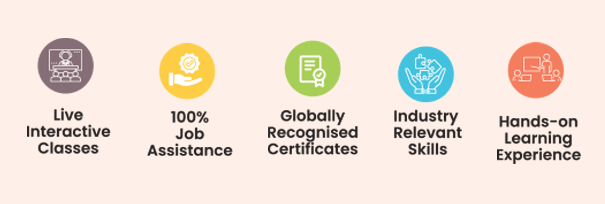Data Analytics is a popular term these days, and we are sure you may have heard a lot if you live in the twenty-first century. It is currently one of the most popular terms. This is the right read for those who want to start their journey in data analytics.
This blog is your essential guide to data analytics and it will assist you in comprehending the subject from the ground up. This will be your learning experience for an enriching career for all you newbies who enjoy playing with data.
What is the meaning of Data Analytics?
Every day, companies all over the world generate massive amounts of data in the pattern of log files, web servers, transactional data, and numerous customer-related data. Not only this, the data generated on social media websites is in massive amounts.
Companies should ideally utilize all of their data generated to derive value and make important business decisions. This goal is driven by data analytics.
Data analytics is the method of examining and analyzing large datasets in order to uncover hidden patterns, and unexplained trends, discover correlations, and derive valuable insights for making business predictions. It boosts your company’s speed and efficiency.
Businesses perform data analytics using a variety of modern tools and technologies. In a nutshell, this is data analytics for beginners.
The Different Ways to Utilize Data Analytics
Now that you’ve learned what data analytics is, let’s look at how we can use it.
-
Elimination of Assumptions: Data Analytics improves decision-making by eliminating guesswork and manual tasks. Whether it’s selecting the right substance, making plans and marketing campaigns, or creating new products. Organizations can use data analytics insights to make more informed decisions. As a result, better outcomes and customer experience are achieved.
-
Improved Customer Service: Data analytics enables you to customize customer service to their specific requirements. It also does provide personalization and strengthens customer relationships. Data analysis can reveal details about a client’s preferences, concerns, and more. It enables you to make more accurate product and service recommendations.
-
Efficient Transactions: Data analytics can help you simplify your procedures, save money, and increase production. You spend less time generating ads and information that aren’t relevant to your audience’s interests when you have a better understanding of what they want.
-
Valuable Insights: Data analytics can provide useful insights into how one’s campaigns operate. This aids in fine-tuning them for the best results. You can also spot possible clients who are most likely to engage with an initiative and convert into leads.
Steps Involved in Data Analytics:
The following step in comprehending data analytics would be understanding how data is analyzed in groups. The data analytics lifecycle consists of several steps. Let’s look at it through the lens of an analogy.
Assume you own an e-commerce company with a customer base of nearly a million people. Your goal is to identify specific business problems and then develop data-driven solutions to help your company grow.
The steps you could indeed take to resolve your problems are listed below.
-
Comprehend the issue: The first task in the analytics process is to understand the business problems, define the organization’s objectives, and plan a profitable solution. E-commerce businesses frequently face challenges such as predicting item returns, providing relevant product recommendations, canceling orders, detecting fraud, optimisation of vehicle routing, and so on.
-
Data Collection: Next, you must capture transactional business data and consumer information from previous years in order to address the issues that your company is experiencing. The data can include information such as the total number of units purchased for a product, sales and profit, and when the order was placed. Data from the past is critical in shaping a company’s future.
-
Data Cleaning: All of the data you collect now is likely to be irregular, cluttered, and encompass undesirable missing values. Such data is neither suitable nor relevant for data analysis. As a result, you must clean the information to eliminate undesirable, superfluous, and missing values before it can be analyzed.
-
Information Gathering and Analysis: After collecting the necessary data, the next critical step is to conduct exploratory data analysis. To analyze, visualize, and predict future outcomes from this data, you could use visualization tools and business intelligence tools, data mining techniques, and predictive modeling. Using these methods, you can figure out the effect and correlation of a specific feature in relation to other variables.
The analysis yielded the following results:
- You can tell when a customer buys the next product.
- You can see how long it took to get the product to you.
- You gain a better understanding of the types of items that customers seek, product returns, and so on.
- You will indeed be able to forecast sales and profits for the coming quarter.
- You can reduce order cancellations by shipping only relevant products.
- You’ll be able to determine the fastest way to deliver the item for example.
-
Analyze the result: The final stage is to analyze the findings and validate whether or not the consequences meet your expectations. Hidden patterns and development outlooks can be discovered. This will assist you in gaining insights that will assist you in making appropriate data-driven decisions.
Data Analytics Tools:
Now that we’ve looked at the various steps involved with data analytics, let’s look at the tools used to perform the aforementioned steps. This blog will go over 7 data analytics tools, as well as a few programming languages, which can help you deliver better analytics.
-
Python: Python is an entity-oriented open-source programming language. It supports a variety of library resources for data manipulation, visualization, and modeling.
-
R: R is an open-source language of programming that is primarily used for quantitative statistical analysis. It includes a number of library services for data visualization and analysis.
-
Tableau: Tableau is a streamlined data visualization and predictive analysis tool. This enables you to create a wide range of visual representations to present the information asynchronously, as well as reports and dashboards to highlight insights and trends.
-
Power BI: It is a tool for business intelligence with simple ‘drag and drop functionality. It claims to support multiple data sources and has data visualization features. Power BI includes features that allow you to ask questions of one’s data and also get instant solutions.
-
QlikView: QlikView combines engaging data analysis with in-power storage to analyze massive amounts of information and then use data discoveries to aid decision-making. This tool is known for offering users social data discovery and engaging guided analytics. It can instantly and accurately manipulate massive data sets.
-
Apache Spark: Apache Spark is an open-source analytics engine that performs sophisticated analytics on real-time data utilizing SQL statements and machine learning algorithms.
-
SAS: SAS is a data analysis software that can assist you in performing analytics, visualizing data, writing SQL queries, performing statistical analysis, and developing models using machine learning to make predictions about the future.
Now that you’re familiar with the data analytics tools, let’s move on to the data analytics applications.
Data Analytics Applications:
Data analytics is being used in nearly every single business sector; here are a few examples:
-
Retail: Data analytics enables retailers to better understand their customers’ needs and purchasing habits in order to forecast trend lines, strongly suggest new products, and grow their business.
At each stage of the customer journey, they maximize the supply chain and retail operations.
-
Healthcare: The healthcare industry analyzes patient data to provide potentially life-saving diagnoses and treatment options. Data analytics is also useful for discovering new drug development techniques.
-
Manufacturing: With the usage of data analytics, the manufacturing sector can come up with several effective new cost-cutting opportunities. They are capable of resolving difficult and complicated supply chain issues, labor shortages, and equipment breakdowns.
-
Banking Sector: Financial institutions and banks use analytics to identify potential loan defaulters and customer defection rates. It also assists in the detection of fraudulent transactions immediately.
-
Logistics: Data analytics is used by logistics businesses to create new models of operation and optimize routes. This, in turn, offers the users a guarantee that the delivery is on time and at a fairly reasonable cost.
Data Analytics as Career:
Data analytics is a fantastic career path. There has never been a better time to become a data scientist. Every day, roughly 2.5 quintillion bytes of information are created, and the rate of growth is only increasing. Data Analysts are at the forefront of this movement in the face of this data explosion; as organizations’ data collection expands in scope and sophistication, they will invariably want to use that data. Begin Data Analytics Online Training if you want to work in this field.
Furthermore, Data Analysts can benefit from their ability to collaborate and participate in high-level decision-making, which can lead to management positions. Data analysts are all in high demand and short supply, and their pay reflects that. Furthermore, many Data Analysts enjoy the chance to travel and work remotely, or to relocate to a new city or country. Even if the work isn’t for you, the advantages, salary, and stable employment will be well worth it.
Job Opportunities for Data Analysts:
Because of the short supply and high demand for their services, data analysts have quite a great future. IBM predicted a supplemental 364,000 (to 2,720,000) data-related jobs in the United States alone by 2020. Another Dresner Advisory Services survey found that big data is used in corporate firms increased from 17% in 2015 to 59% in 2018; other references endorse this trend.
Tech companies are not the only ones jumping on board. Data analysis skills can be applied in a wide range of industries. Big data analytics was most widely used in telecommunications, insurance, and advertising. According to the Dresner study, insurance was the most likely to use big data analytics, being followed by financial services, health insurance, and technology (71 to 65%), and it was most frequently used for research and development (75%). (Sixty-three percent).
Big data holds the potential to transform entire industries, and data analytics adoption shows no signs of slowing. Recent McKinsey research on digital analytics predicted data-activated, one-to-one marketing engagements and operations, as well as manufacturing. Many other industries have yet to fully realize this promise. According to the study, if the healthcare industry in the United States used big data to improve efficiency and quality, it could generate more than $300 billion in value, as well as a big retailer could boost its operating margin by more than 60%. As a direct consequence, they do not expect the above expansion to slow anytime soon.
Career as Data Analyst:
The sector within which a Data Analyst works heavily influences their path to success. For entry-level positions as a Data Analyst, a bachelor’s degree in statistics, mathematics, or computer science may well be sufficient. Some employers, in contrast, prefer applicants with a credential. People who have previously worked in a related field such as business, economics, or even the social sciences may be able to transition into data gathering by trying to take a data analytics course in their mid-career. Data Analytics Training in Delhi is an excellent choice.
A Data Analyst may be an entrance career in data science, depending on the required experience. When compared to a Data Scientist, a Data Analyst is a lower-level position. As a data scientist, you may be required to participate in more strategic planning, have a more sophisticated collection of technical abilities, and an understanding of programming languages. The average salary of a Data Analyst is higher than that of a Data Scientist. Nonetheless, with the right experience and training, a Data Analyst can be transformed into a Data Scientist.
Conclusion:
To advance up the ranks to the position of Senior Data Analyst, you’ll have to have a basic understanding about everything. If they have gained enough broad and deep experience, a knowledgeable Senior Data Analyst could indeed lead a group of other Data Analysts. With additional training, data analysts can advance to become Data Scientists or other high-level data analytics positions. Data analytics can be a rewarding career path.
Frequently Asked Questions:
- What is the importance of Data Analytics?
Data analytics is critical for understanding trends and patterns in the massive amounts of data being collected. It aids in the optimization of business performance, forecasting future results, understanding audiences, and cost reduction.
- What are the four kinds of data analytics?
Predictive data analytics, Prescriptive data analytics, Diagnostic data analytics, and Descriptive data analytics are the four types of data analytics.
- Who is making use of data analytics?
While every business uses data analytics to understand their operations, the four top sectors that use data analytics are retail, agriculture, banking, and government.
- What exactly is the distinction between data analytics and data science?
Data science is an umbrella term that encompasses a variety of fields that use large datasets to mine meaningful correlations. Data analytics is more concerned with identifying specific trends and generating actionable insights.
- What are the prospects for advancement in data analytics?
Beginning as a Data Analyst, you can advance to Analyst II, Senior Analyst, Data Scientist, and even Chief Technology Officer.
- What is the purpose of data analytics?
Data analytics is employed to make sense of massive amounts of data in order to uncover trends and insights that will help businesses grow.





 Whatsapp us
Whatsapp us Call us
Call us





